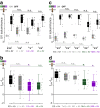Different spectral sensitivities of ON- and OFF-motion pathways enhance the detection of approaching color objects in Drosophila
- PMID: 38001097
- PMCID: PMC10673857
- DOI: 10.1038/s41467-023-43566-8
Different spectral sensitivities of ON- and OFF-motion pathways enhance the detection of approaching color objects in Drosophila
Abstract
Color and motion are used by many species to identify salient objects. They are processed largely independently, but color contributes to motion processing in humans, for example, enabling moving colored objects to be detected when their luminance matches the background. Here, we demonstrate an unexpected, additional contribution of color to motion vision in Drosophila. We show that behavioral ON-motion responses are more sensitive to UV than for OFF-motion, and we identify cellular pathways connecting UV-sensitive R7 photoreceptors to ON and OFF-motion-sensitive T4 and T5 cells, using neurogenetics and calcium imaging. Remarkably, this contribution of color circuitry to motion vision enhances the detection of approaching UV discs, but not green discs with the same chromatic contrast, and we show how this could generalize for systems with ON- and OFF-motion pathways. Our results provide a computational and circuit basis for how color enhances motion vision to favor the detection of saliently colored objects.
© 2023. The Author(s).
Conflict of interest statement
The authors declare no competing interests.
Figures








References
-
- Spelke ES. Principles of object perception. Cognitive Sci. 1990;14:29–56. doi: 10.1207/s15516709cog1401_3. - DOI
Publication types
MeSH terms
LinkOut - more resources
Full Text Sources
Molecular Biology Databases
Research Materials
Miscellaneous

